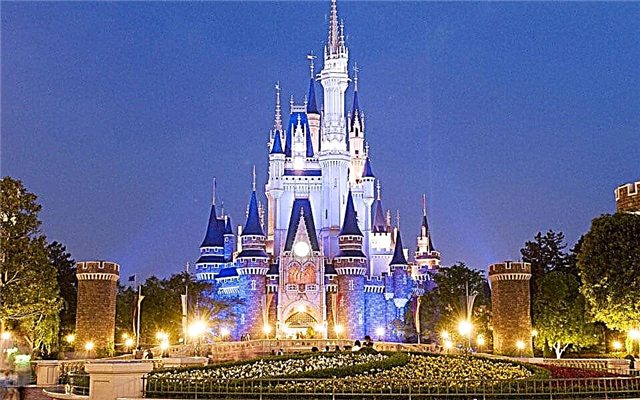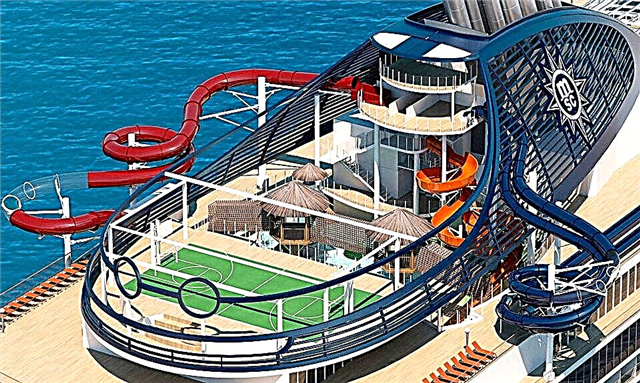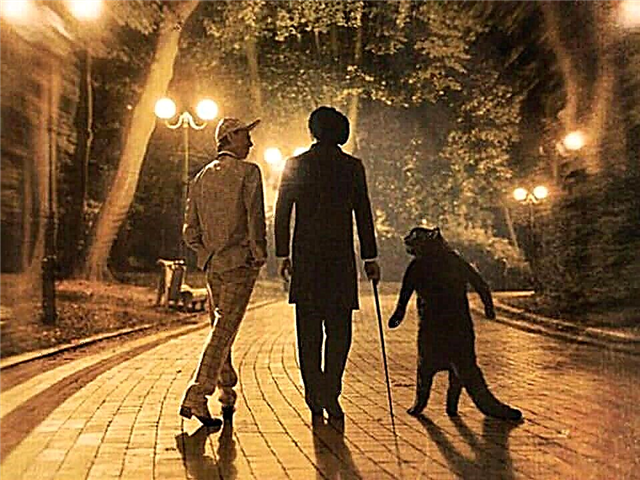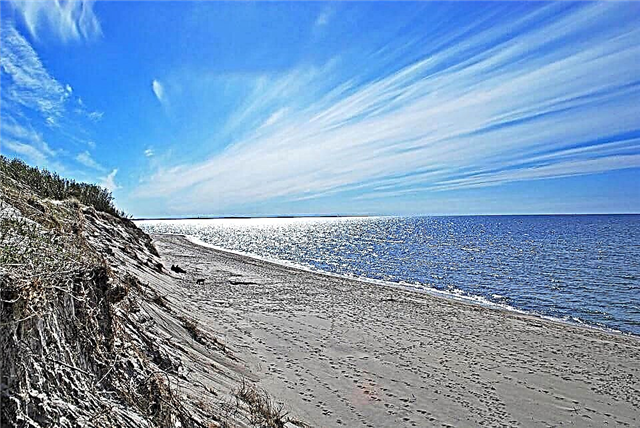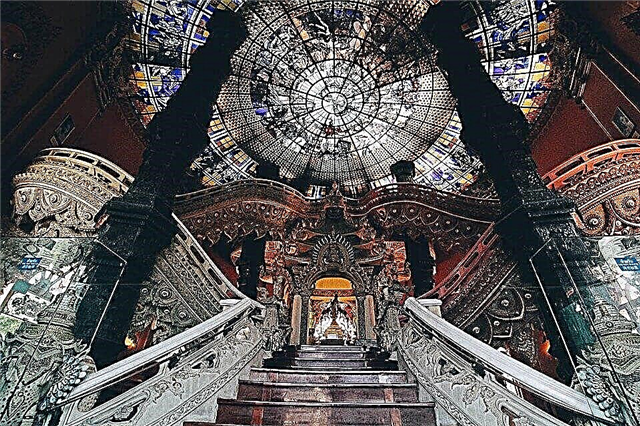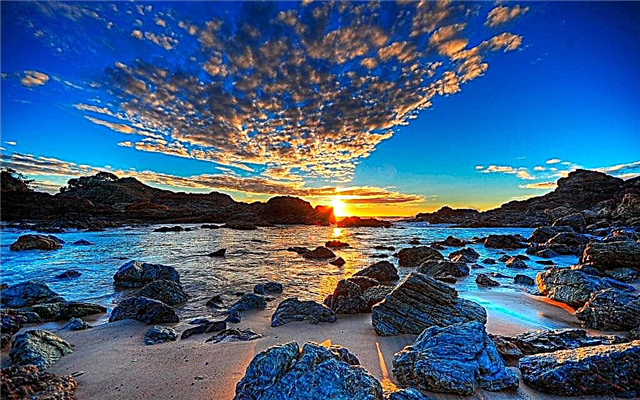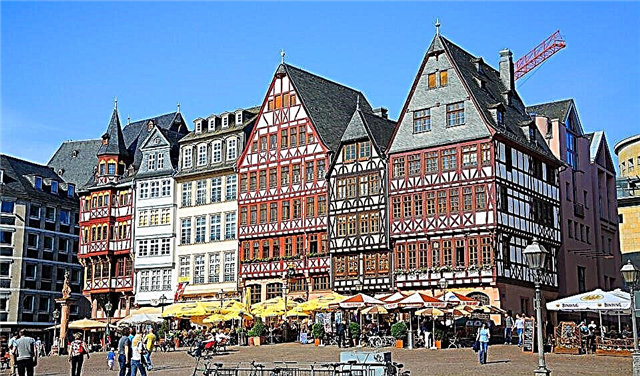Frankfurt am Main is the most beautiful city, the fifth largest in Germany. Without exaggeration, it is the heart of the German lands in terms of economy, education, tourism and culture. The sights of Frankfurt am Main amaze with their diversity: these are ancient churches, and stunning skyscrapers, and interesting museums. The abundance of curious places scatters eyes, but it is certainly worth starting from the most resounding tourist points. Let's figure out together what is worth looking at first.
Banks Quarter

The Bank Quarter in Frankfurt am Main is called the central business district of the city, and of all Germany as a whole. It is considered to be the economic heart of the country and one of the largest financial centers in Europe. The quarter does not have a clear border separating it from neighboring areas, but it is mainly determined by the terrain in the west of Innenstadt, south of Westend and the eastern part of the Bankofsviertel. Its central square is called Opernplatz. Most of Germany's largest banks are located in this area, for example, Commerzbank and Helaba. In addition, branches of foreign banks are located here.
In fact, this is a kind of tiny metropolis in a metropolis with an impressive infrastructure. The second New York City Manhattan with many skyscrapers, office buildings, restaurants, hotels. The highest office building in Europe has long been considered the local Commerzbank Tower with a height of just over 250 meters, which only recently gave way to Moscow's Triumph Palace. Despite the fact that the bank quarter is far from the most ancient and curious sight of the city, it is a place where you can fully experience the atmosphere of German clerks.
Romerberg Square

Postcards depicting the famous square are sold in every gift shop. And, even if you were not lucky enough to visit Frankfurt am Main, visually you are most likely familiar with Romerberg. In fact, it is the historical center of the city, a beautiful, authentic place. In the ninth century, fairs, tournaments, festivals, executions and coronations were held here, and in the fifteenth, a government settled.
In the 16th century, the famous "Justice" fountain was installed in the center of the square with the statue of Justice in the center. A few steps from the fountain there is a memorial plaque dedicated to the books burned by the National Socialists in 1933. The eastern row of Römerberg's home is characterized by frame buildings, which were erected in 1986 in accordance with historical plans.
Roemer

Römer Square is one of the most remarkable sights of Frankfurt am Main. Its name comes from the town hall located here, and in translation means “Roman”. In 1405, the city council bought local buildings from the merchant Kunz, and over the years, nine more buildings (11 in total) and several courtyards were added. More than one significant event took place on Römer Square, as evidenced by 52 photographs with the Kaisers captured on them.
The famous town hall suffered serious damage during the Second World War. Its reconstruction began in 1945 and it was reopened in 1955. The most famous point on the square is undoubtedly the Römer balcony, from which many prominent German figures waved to the crowd.
Hauptwache square

The Hauptwache, often pronounced in Russia as the Guardhouse, is the central and most recognizable square of Frankfurt am Main. Until the beginning of the twentieth century, it was called Schillerplatz. The main architectural element is, without a doubt, the Baroque building, which previously served as the headquarters of the guardians of the law. The square itself was rebuilt several times.
The current design features a recessed terrace leading to an underground pedestrian area with shops and a public transport station. What is also remarkable about Hauptwach is the amazing combination of architectural styles. In addition to the headquarters building, the Church of St. Catherine is especially prominent, around them - "newcomers" were built, taking the place of buildings destroyed during the Second World War.
Museum embankment
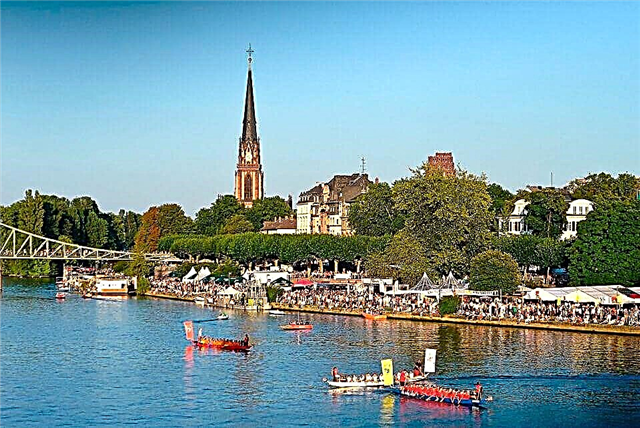
The Museum Embankment in Frankfurt am Main is an amazing place and a real treasure for all art lovers. On the south bank of the Main, nine exhibition buildings are lined up one after another, like pearls in a necklace. From west to east, they are called:
- Hirsch Museum
- Liebeghaus
- Staedel (art institute)
- Museum of Communications
- Museum of German Architecture
- Museum of German Cinematography
- Museum of World Cultures
- Museum of applied arts
- Museum of icons
In addition to the opportunity to visit each museum separately, tourists can participate in one of the largest art festivals - Museum Night, which takes place annually in August.
Senckenberg Museum

Senckenberg Museum of Natural History is one of the most visited in Frankfurt. In 2003, the venerable old building, built in 1907, with its impressive exhibition on the history of the planet and evolution, was heavily modernized. It houses one of the most significant European natural history collections. Many of the thousands of exhibits are extremely rare and unparalleled.
More than four hundred thousand people visit the museum annually. Fascinating and sometimes scary pictures open before them. For example, how a huge anaconda devours a wild boar or the skeleton of "Lucy" - an ancient man. But, of course, the most impressive exhibits are dinosaurs.
Opening hours:
- Monday, Tuesday, Thursday and Friday - 9: 00-17: 00
- Wednesday: 9: 00-20: 00
- Saturday and Sunday: 9: 00-18: 00
Ticket price: 10 euros.
Goethe House Museum

The Goethe House-Museum is located exactly where it belongs - in the homeland of the great poet and thinker. The building, built in the seventeenth century, was destroyed in the bombing of the Second World War. Nevertheless, the old house has been completely restored in the form as close as possible to the original building. The furnishings of the kitchen, living room and reception rooms are fully consistent with the bourgeois life of the late Baroque. Goethe's studio room looks the same as it did during the life of the creator.
It was here that he wrote the famous "Faust" and "The Suffering of Young Werther". The museum has an extensive collection of paintings, sketches and busts from the 18th and 19th centuries, from the late Baroque and Classicism to Romanticism and Biedermeier. This exhibition clearly shows the connection between the writer and art. Well, at specially organized exhibitions, visitors can see archival materials on Goethe, for example, excerpts of manuscripts and some confidential documents.
Opening hours: Monday to Saturday from 10:00 to 18:00, Sunday and public holidays from 10:00 to 17:30. Ticket price: 7 euros, children under 6 years old - free.
Old opera

The current building of the old opera is entirely the merit of the citizens of Frankfurt am Main, thanks to the protests and generous donations of which, it was completely restored after the terrible bombing. The grand opening took place on August 28, 1981. Since then, the old opera has hosted more than 300 different events every year.
The season starts with the “Auftakt” festival, which is dedicated to contemporary music. Performances of national and international ensembles and soloists are held in the Great Hall (for 2450 seats), in the Mozart Hall (for 720 seats) - chamber and symphony concerts, song evenings. The range of performances is amazing. Here you can find concerts, musicals, jazz performances, and even rock performances! Everyone will find something to their liking.
Frankfurt cathedral

Strictly speaking, in fact, Frankfurt Cathedral is not a cathedral, since it has never been the main church of the bishop. However, the Gothic Cathedral of St. Bartholomew is one of the few to have received the resounding title of “Imperial Cathedral” (Kaiserdom). Since 1356, according to the decree of Charles IV, kings have been elected here. Between 1562 and 1792, ten monarchs were crowned by emperors in front of the cathedral's altar. The modern church is the fifth building on this site.
Over the years, the territory of the cathedral expanded, and when, in 1867, a major fire took place, an extensive restoration was carried out in the neo-Gothic style. At the same time, a spire was installed on the tower, which rises to 95 meters. In addition, the interior and exterior of the cathedral had to be seriously worked on after the devastating war. Visitors can admire not only the cathedral itself, but also visit the museum in the medieval monastery. From April to October, you can climb the tower, although for this you have to pass 324 steps. The cathedral hosts both morning and evening services, which can also be visited.
St. Paul's Church

St. Paul's Church was first consecrated in 1833 as the main Evangelical Lutheran church in the city of Frankfurt am Main. The elliptical central building, made of red sandstone, had the largest and most modern hall in the city, and it was here that the meeting of the first all-German parliament took place. In 1944, the church was completely destroyed, but its reconstruction was not long in coming.
It was consecrated on May 18, 1948 to commemorate the centenary of the German National Assembly. Since then, the church has been a kind of symbol of the beginning of German democracy. Sometimes public exhibitions are held on the lower floor, but in general, the church serves as a venue for state and municipal events.
Church of St. Justin

The church is located in the Höchst district and is the oldest building in Frankfurt am Main. Its three-story basilica was built since 830, and, surprisingly, it has survived to this day. In general, the Church of St. Justin is a happy exception, as it is one of the few fully preserved churches in Germany from the early Middle Ages. The interior is decorated in medieval and baroque style. In the western part you can find a crucifix also in the Baroque style.
Opening hours: from April to October - from 14:00 to 17:00 (Tuesday-Sunday), from November to March - from 14:00 to 16:00.
Europaturm

Europaturm is a television tower with a height of 337.5 meters. It was designed by Erwin Heinle. The construction itself began in 1974. The top of the tower can be turned to reveal a panoramic view of the Rhine. For several years, a restaurant and a nightclub functioned at the top, but since 1999 Europaturm has been closed to the public. In 2004, the tower antenna was replaced and is now capable of broadcasting HDTV signals. The tower itself is owned by T-Systems, whose primary color is magenta. It is in it that the evening illumination of Europaturma is made.
Maintower
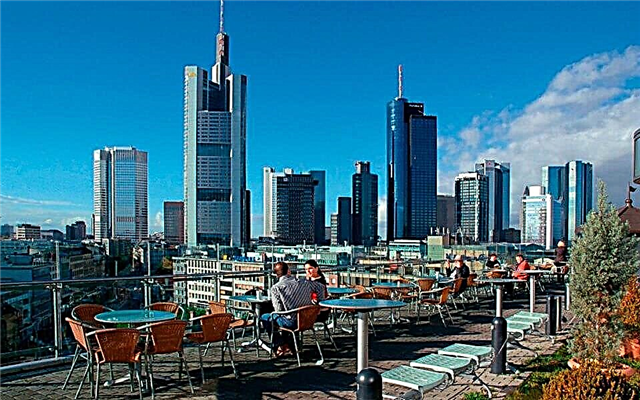
When the Maintower was completed in 1999, even the pampered locals in Frankfurt am Mike were impressed. For the first time in Europe, a multi-storey building with a glass facade was built. In fact, the Maintower consists of two high-rise buildings that are interconnected with each other. One of them is square, 170 meters high, the other is rounded, about 200 meters high, made of non-reflective glass.
This multi-storey building is especially popular with city residents and tourists. It is the only one in the city that has a public observation deck with a restaurant. In addition, the most popular radio and television studios are located on the 53rd and 54th floors, respectively.
Opening hours: Observation deck - from 10:00 to 9:00 (Sunday-Thursday) and from 10:00 to 11:00 (Friday-Saturday). Ticket price: 7.50 euros.
Eschenheim tower

At the very end of the Bockenheimer Anlage Park, the Eschenheim Tower shines dazzlingly. It was once one of the forty-two watchtowers of the city's fortifications. But is it just one of many? Rather the most beautiful of all and quite ancient - Eschenheim was built in 1428. The tower is 47 meters high and has eight levels and two attics. Inside the tower there were living quarters for the guard, which were used until 1956.
Today, there is a bar and a restaurant inside the building, which often welcomes tourists and locals. I am glad that the Eschenheim tower managed to survive to the present day almost in its original form, and now it just looks magical in the middle of the urban bustle.
My Zeil Shopping Center

Whatever you want to buy, you will almost certainly find it on Zeil Street, where, without a doubt, the most impressive building is the shopping center of the same name. This six-story shopping cradle was built in 2009 by the Italian architect A. Fuksas. Say what you like, but the creator turned around in full, having built a kind of "whirlpool" or "canyon" into the design. Thanks to him, soft daylight enters the building. The construction budget amounted to almost a billion euros, and within it are located more than eighty high-class stores. Opening hours: 10: 00-21: 00. Sunday is a day off.
Frankfurt old bridge

Surprisingly, the "Old Bridge" of Frankfurt am Main will not be typed even for hundreds of years. The previous structure was replaced in 1926, and later, thirty-five years later, it was reconstructed. However, this fact does not detract from the popularity of the bridge. Until the end of the nineteenth century, the Old Bridge was essentially one of a kind in Frankfurt. There is a very funny legend about its construction. Say, when the master got down to business, the devil came to him and demanded a soul in exchange for help.
He said that the first person to enter the bridge would go with him to hell. The master agreed, but he cheated himself, letting the rooster in front of the people. The width of the modern version of the bridge is almost 20 meters, the length is 237 meters. Like most architectural sites in Frankfurt, the bridge was bombed during the Second World War. As a result, several spans lined with red sandstone were replaced with metal structures.
Eiserner-Steg pedestrian bridge

The Eiserner-Steg iron pedestrian bridge was erected between 1868-1869 by a private company of local residents as the third bridge across the Main. From the very beginning, the bridge was erected exclusively for pedestrians, because on the side of Frankfurt there was no place for the construction of ladders for the road bridge. The Eiserner-Steg was rebuilt in 1911. Initially, in order to cross to the other side, residents came to pay a fee in order to cover the cost of construction.
The fee was canceled when the authorities took control of the bridge. The length of the Eiserner-Steg is 170 meters. During the Second World War, it was blown up by the Nazis, but rebuilt quickly enough, in 1946. In the early nineties, during the renovation, the Eiserner-Steg was completely renovated.
Frankfurt Zoo

In the very center of Frankfurt am Main, there is an extensive zoo, founded in 1858, as a result of which it is rightfully called one of the oldest in the world. The open cages and uniquely designed enclosures are home to a total of over four and a half thousand animals (500 different species). One of the zoo's notable attractions is Europe's largest house of nocturnal animals.
No less impressive is the so-called Exotarium, where penguins, fresh and saltwater fish, reptiles and insects brought from all over the world live. A specially built grotto allows you to observe the inhabitants of the depths, even if they disappeared under water.
Opening hours: in summer - from 9:00 to 19:00, in winter - from 9:00 to 17:00. Ticket price: 10 euros, for children from 6 to 17 years old - 5 euros, under five - free.
Betman Park

At the end of the eighteenth century, the Bethmann bankers decided to equip a wonderful garden around their house, which by the forties of the twentieth century passed to the city authorities, and since 1952 it was opened to the public. The pearl of the park is an amazingly beautiful Chinese garden. This is an exceptional place, imbued with a special calmness and East Asian aesthetics. Protected by thick walls from the hustle and bustle of the city, the garden was built with a reference point to the gardens of the urban district of China Huizhou.
For some five months in 1989, a 4,000 square meter spring flower paradise with a marble bridge, various pavilions, a pond and even a waterfall was laid out here. The garden welcomes guests all year round from 7 am until dark. On weekends and holidays - from 10 am until dark.
Palm garden

In the very heart of the huge metropolis, a real paradise with plants from all over the world is comfortably hidden. Even without traveling to exotic countries, you can plunge into the stunning botanical diversity of the palm garden. One of the iconic points is the Tropicarium, where the plant worlds of various tropical landscapes (savannas, deserts, monsoon jungles) are displayed. And in the center of the garden there is an amazing flower house, where you can admire the sea of beautiful flowers, planted on an area of 200 sq. m. Moreover, regardless of the season.
In addition, various exhibitions and events are constantly held in the garden, including performances by prominent modern botanists and musical groups. In warm weather, even children will not be bored here - there is a playground, a pond with boats, minigolf and even a small railway.
Opening hours: from February to October - 9: 00-18: 00, from November to January - 9: 00-19: 00. Ticket price: 7 euros, for children under 13 years old - 2 euros.
In Frankfurt am Main, GuruTurizma recommends the following hotels:



